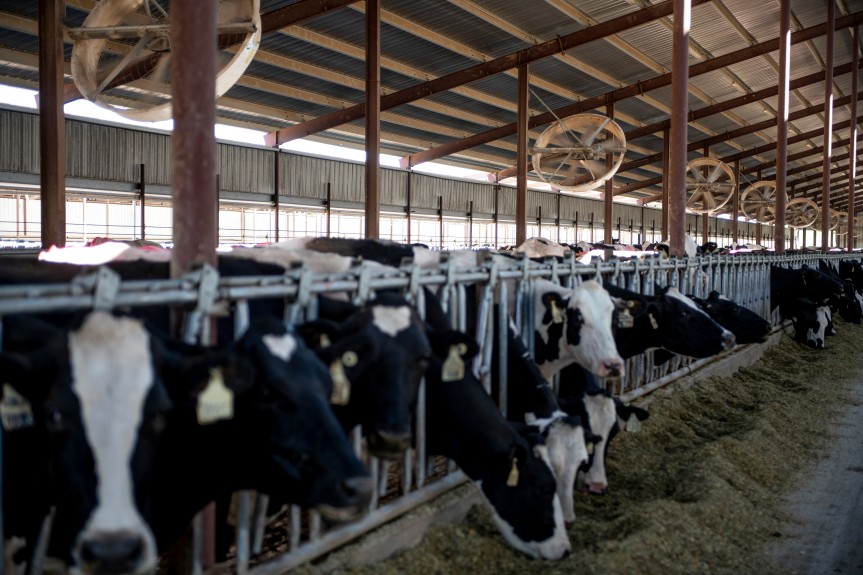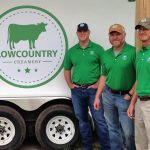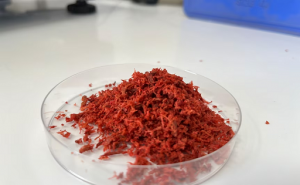
Stores with dairy cases filled with gallons of milk, pints of cream, rows of cheese and shelves of butter make it easy to take for granted the convenience of grabbing what you need and going on your way.
However, for dairy farmers, that gallon of milk or stick of butter took a lot of time, work and money before hitting stores’ shelves.
“Milk doesn’t just come from cows, it comes from people putting in the grind,” said David Walpole, co-owner of Walpole Dairy, north of Eaton. “You’ve got to have the passion and dedication day in and day out. It has its rewards and it has its tough times.”
A family affair
The Walpole Dairy has been around 40 years, Walpole said. The dairy has a few hundred dairy cows in its herd.
“My dad started over on 5th Street, across from the church,” Walpole said. “He milked there and then he bought this place.”
Walpole’s kids— five daughters and one son — as well as his brothers, nieces, nephews and mother, Bonnie, still work on the farm. His father, Kent Walpole, takes care of all of the cows’ veterinary needs.
While some of Walpole’s kids aren’t sure if they want to continue the tradition of dairy farming, they definitely want to work in an animal-focused industry, Walpole said.
Eric Blaser, manager of Long Meadow Farm, LLC in Greeley, is a fourth-generation dairy farmer. While Blaser doesn’t own Long Meadow Farm, the dairy is a family-owned farm. The dairy has around 5,100 cows and calves currently housed at the farm.
“To me it’s not really like a job. It doesn’t feel like a job because it’s what I’m passionate about and enjoy,” Blaser said. “It’s a lot of fun, it doesn’t come without its challenges, but it’s something I’ve been involved with my entire life.”
Growing up on a dairy farm has benefits that other environments don’t normally offer youngsters and teens, Blaser said.
“You get exposed to a lot of things early on, and it teaches you a lot of things early on,” Blaser said. “You learn about responsibility and how to interact with animals. It’s a skill you can perfect over time.”
The pregnancy process
Dairy cows are bred for their ability to produce milk. In the U.S., there are seven different types of dairy cow breeds — Holstein, Jersey, Brown Swiss, Guernsey, Ayrshire, Milking Shorthorn and Red and White Holstein.
Holstein cows, with their iconic white and black patterns, are the most common of milk cow breeds. The cows produce more milk than any other dairy cow breeds.
Both Blaser and Walpole raise and use Holstein cows at their dairy farms.
Holstein cows’ spots are like fingerprints — no two cows have the same pattern.
In order for cows to produce milk, they must be pregnant. Cows will continue to lactate for about 10 months after birthing a calf, during which time she is inseminated and becomes pregnant again.
“Usually an animal gets to be around 14 months old, and we will inseminate them and breed them,” Walpole explained. “They have to reach a certain size to have a calf. We usually do a 13-month rotation so they will have a calf every 13 months.”
Like humans, a cow is typically pregnant for nine months, Walpole said. Once the calf is born it is moved to a separate pen where it is bottle-fed and cared for until it is old enough to be moved to a group area with other cows its age.
Calves can start with bottle-feeding of high-quality colostrum and begin eating solid food like grain and hay at around two-days old.
“If you take care of them really well in the first 60-days, your cows are going to be healthier and live a lot longer,” Blaser said. “We have a really expansive vaccination protocol that protects them against respiratory disease and any viral diarrheas.”
Male calves are sold to ranches, farms and feedlots to be raised and processed for the public food supply.
Cows’ genetics can be tailored to a variety of needs through the use of semen consultants.
“They have this huge book, and you can go through it,” Walpole said. “They do DNA tests and take samples from cows. They know the traits of the animal two years before she starts lactating.
“You can buy semen from different bulls to accommodate what you need in your herd of cows. The trend is to produce smaller cows to make them more feed-efficient.”
Pregnant cows are usually moved to the maternity section of the farm when they are around two-months out from birthing, Blaser said. This process, called “drying-off,” allows the cows to rest and reserve energy for the birthing process.
Cows are inseminated again after around two months after giving birth, Blaser said. The dairy’s goal is to have each cow birth a calf once a year.
“It’s kind of a continual schedule that we attempt to keep them on as best as possible,” Blaser said.
Caring for cows is a 24/7 job
There’s more to owning a dairy farm than just throwing down some hay and making sure the cows have clean water. It’s a year-round, 24-hour per day job that needs to be done no matter the weather or if it’s a holiday.
“The cows don’t take a day off, and that’s the challenge in it. But, what we try to do here is focus on how to develop our employees, how to develop our management and how to create leadership when we are not here,” Blaser said. “We focus on those things everyday just so that we can allow ourselves vacation and family time.
“You have to create a balance between work and family life, otherwise you’re not going to last.
Blaser’s and Walpole’s days start off early in the morning with checking on the cows and any new calves that were born overnight. From there, the list of duties that need to be done is endless.
Ordering more food; scraping the barns; moving cows around to different pens; seeing which cows are ready to breed and which cows are ready to birth; checking if cows are feeling sick and which ones need medication; and scheduling the farrier to come in check the girls’ feet are just a portion of the things that need to be done on the farm.
“We try to keep the corrals as comfortable and clean as possible,” Walpole said. “The corrals get scraped twice a day and clean hay gets laid down. We make sure their beds are soft and they are comfortable.”
A cow’s diet can affect her health as well as the quality of milk she produces, so Blaser and Walpole are always on top of what food the cows are eating and how much they are getting each day.
Part of caring for cows is making sure they are milked regularly and cared for with compassion and kindness.
“We focus on how to handle the cows to make sure they aren’t being roughed,” Blaser said. “We try to have our employees not whistle or anything like that. There’s no room for hitting or abusing cows. We won’t stand for that.”
Employees on Blaser’s farm sign a contract with a list of expectations of animal handling and an agreement that if they see someone mistreating an animal, they will alert management immediately. Abusing an animal is grounds for immediate termination.
“These girls are what provide us a living, and we need to take care of them as best as possible,” Blaser said. “They deserve respect, and that’s what we try to do everyday.”
In addition to taking care of the cows, maintenance on equipment and machinery needs to be done, as well as general maintenance of fences, pens and such.
“We do as much of the servicing ourselves as we can,” Walpole said. “Equipment costs a lot of money and we are running kind of older stuff. A new tractor like the one we have would cost darn near $120 grand.”
The rise of technology in the dairy industry
Gone are the days when farmers got up early to hand-milk their herds. As farms have grown to supporting cows numbering in the hundreds and thousands, technology has also evolved.
Automatic milking machines have taken the place of the stool and milk bucket.
Two to three times per day, cows are taken to the milking parlor, where they file into stalls. As each cow enters the milking parlor, an ear chip or collar gets scanned, relaying a variety of information back to Walpole and Blaser, such as the identification of the cow, how much milk the cow produced, how many times that day the cow has been milked and more.
Employees then clean cows’ udders with sanitizing solution and brushes in preparation to be milked.
Once ready, employees then attach a milk controller to each of the cows’ teats and the milking process begins.
Depending on the cow, the milking process can take anywhere from 2 to 15 minutes.
Once finished, the milking controllers are removed, the cows’ teats are sprayed with iodine to prevent infections, and the cows mosey back to the barn to eat, drink and rest until the next milking session.
“I think back to my grandparents when they hand-milked their cows and I feel lazy,” Blaser said, laughing. “The technology that we have now makes everything so efficient.”
Automatic milkers record the amount of milk collected from each cow during each milking as well as a total of milk collected throughout the day.
While Blaser’s cows have ear chips, Walpole uses collars to keep track of his herd.
The collars act as a type of “Fitbit” for his cows, tracking their health, breeding cycle, temperature, activity and sleep levels, identifying animals under heat or cold stress, and more.
“We know if they are sick before they know they are sick. We use technology to help us take care of our animals,” Walpole explained. “
Computer programs have been designed to allow farmers to track cows’ genetics and family lines as well.
Technology is also used to maintain cooling temperatures and track the filling of milk tanks.
Blaser uses a program that tracks the temperature and quantity of his milk tanks.
Information on Blaser’s tanks can be accessed by the milk transporting company to determine when they need to come out and collect the product. This access to information helps alleviate unnecessary trips or full tanks putting a halt on the collection of milk.
“If DFA ever has a shutdown or something, they can look at the data from my tanks and say, ‘OK, Long Meadow has four more hours of milking,’ and they can call me and let me know about the delay,” Blaser said. “That lets us make a decision to what we need to do on our end. They don’t want us to not milk, and we don’t want to be forced not to milk — it’s a bad situation for them and us. So these tools help us mitigate any issues.”
Testing, testing and more testing
Milk that is harvested from cows passes through a filtering system before making its way into the milk tanks to wait for the milk trucks.
Before a milk truck even begins pumping milk from a dairy farm’s tank, operators check the temperature and test it for any antibiotics and white blood cell counts.
Milk that tests positive for antibiotics is immediately dumped.
There are also regulations as to how long milk can stay in tanks on a farm, Walpole said.
The milk is also tested again when it gets to the manufacturing plants.
Milk is one of the safest food products on the market because of all the testing that takes place, both Walpole and Blaser said.
Co-ops and dairy organizations keep the milk flowing
Dairy Farmers of America, or DFA, assists farmers with a variety of needs such as helping with financing, insurance options and management tools. DFA also represents and advocates for dairy farmers at state and national government levels.
The organization is composed of family farmers from across the U.S. that are divided into seven regions — Central, Mideast, Mountain, Northeast, Southeast, Southwest and Western areas — with Colorado, Idaho and Utah making up the Mountain area with 251 member farms broken into 11 districts.
Both Blaser and Walpole sell their milk to the DFA, which then transports it to one of its manufacturing plants like Leprino or a partner plant.
Dairy MAX is a nonprofit dairy council that represents more than 900 dairy farms across eight states, including Colorado.
According to its website, the organization works to build “understanding around dairy as a healthy, beneficial, everyday food choice; connecting the role of the dairy farmer to American tables; and driving an increase in dairy consumption.”
The organization also assists farmers with marketing, industry image and relations, education on issues, crisis management and business development.
As the cost for care rises, dairy farmers’ pay remains the same
The consumer price for a gallon of milk, a block of cheese or a tub of butter fluctuate, but the price farmers are paid for milk hasn’t changed in years, Blaser said.
Dairy farmers are paid per 100 pounds of milk, Walpole explained. Right now, dairy farmers are getting around $17 per 100 pounds of milk. With a gallon of milk weighing 8 pounds, farmers have to milk a lot of cows to cover overhead and turn a profit.
“We don’t get near the prices in the store,” Walpole explained. “I don’t think the amount dairy farmers get paid has changed in years.”
With schools and restaurants closed down to help control the spread of the virus, a large portion of the dairy market was affected.
“Restaurants and schools use a lot of dairy, and when they closed down, the dairy industry took a big hit,” Blaser said.
Dairy farmers also have to pay to have their milk transported from the farm to the manufacturing plant, Blaser said.
“You don’t get into this business for the money,” Blaser said. “You dairy farm because it’s something you love and believe in. I wouldn’t change growing up on a dairy farm for anything.”
Dairy farm facts
- Milk is a key source of potassium, Vitamin D, Vitamin A, Riboflavin and Vitamin B-12
- A serving of milk fulfills 25% of your daily phosphorus needs and is a healthy source of Niacin
- There is no difference in quality, safety or nutrition between organic and regular milk, only the way milk is produced on the farm
- Hormones are not added to milk. Milk naturally contains certain hormones.
- Flavored milk like chocolate, vanilla and strawberry provide the same nine essential nutrients as white milk.
- Milk from a cow that has been treated with antibiotics is disposed of and never reaches the food supply.
- Vanilla is the post popular ice cream flavor in the U.S.
- Brown cows do not make chocolate milk
- All 50 states have dairy farms
- Cheddar is the most popular natural cheese in the U.S.
- June is National Dairy Month
- Cows don’t really sleep much and when they do, they lay down, making “cow tipping” a myth.
Sources: Dairy Farmers of America, Drink-Milk.com

























